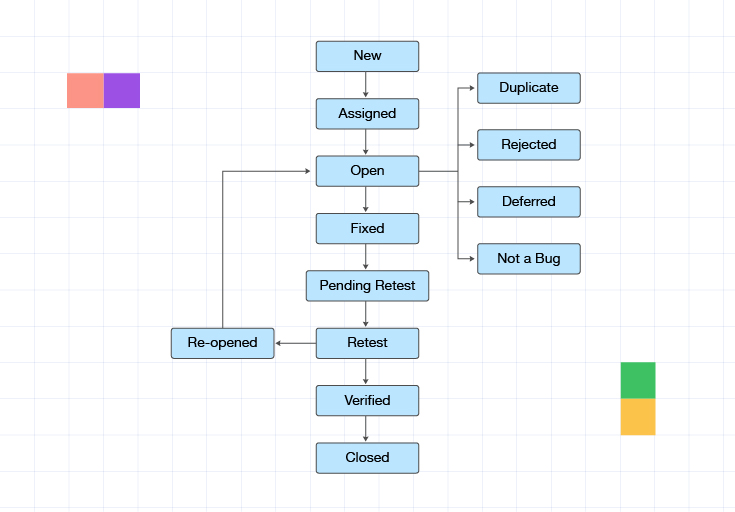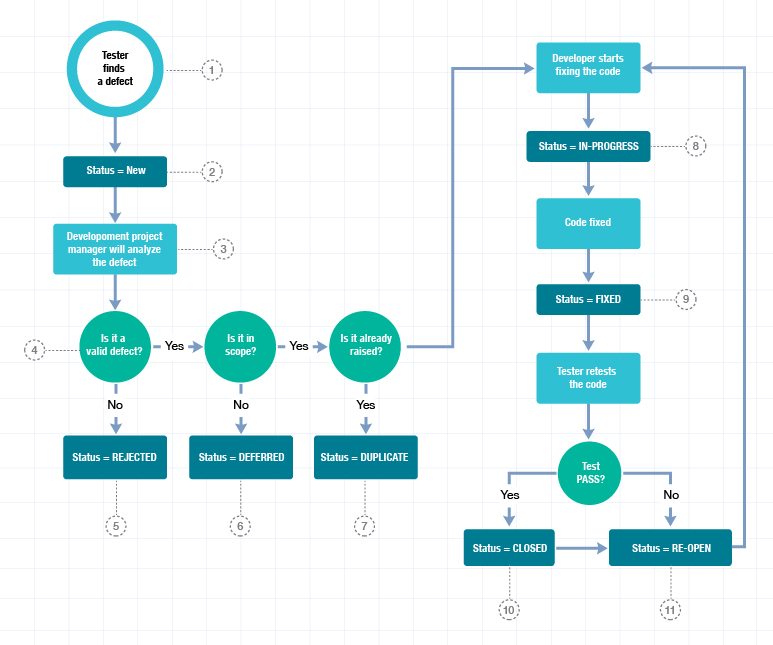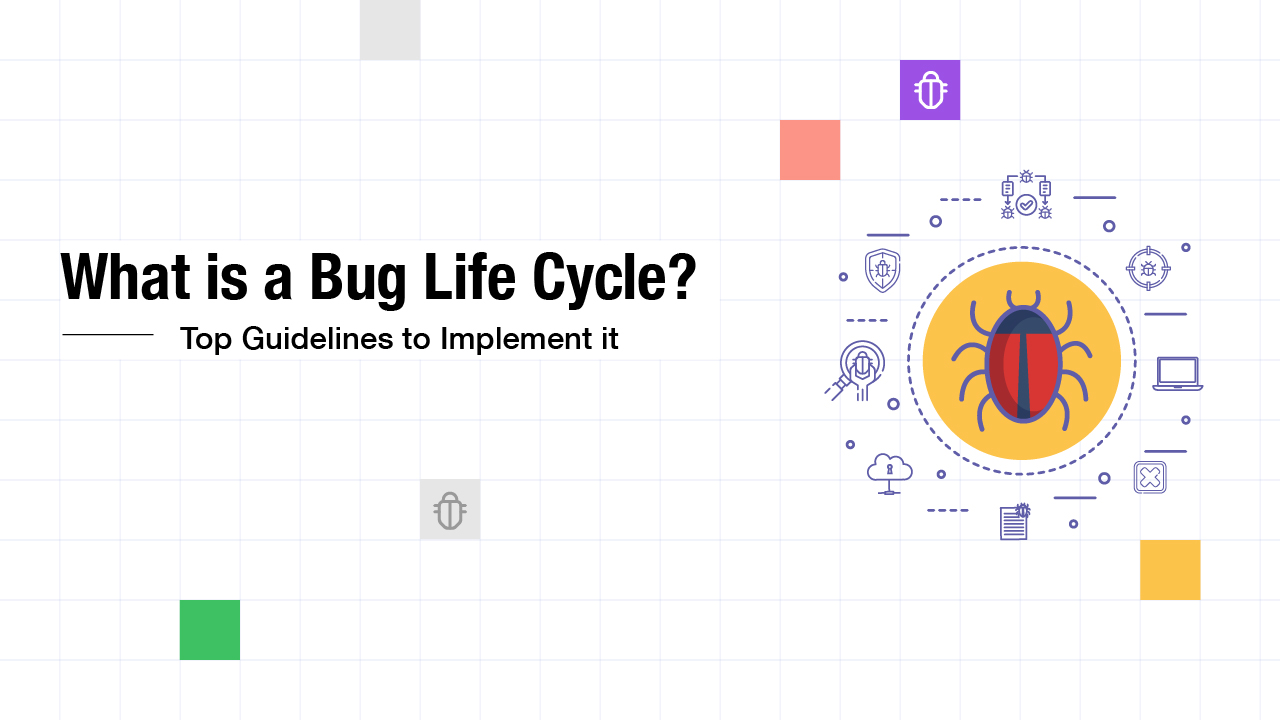Start automating your tests 10X Faster in Simple English with Testsigma
Try for freeA bug life cycle (also known as a defect life cycle) refers to the journey of a defect in which a defect passes throughout its lifetime. It entails all states ranging from the detection of a new defect to the closing of the particular defect by a tester. Typically, the bug life cycle in software testing depends on the organisation and the project. The reason is that the software testing process controls it, and it also depends on the tools used. After having a brief on what is bug life cycle, you will be made familiar with what a bug/defect is.
Table Of Contents
- 1 What is Bug/Defect?
- 2 What Is a Bug Life Cycle(Defect Life Cycle)?
- 3 Defect/Bug Status
- 4 Stages of Bug Life Cycle in Testing.
- 5 Who Performs a Bug Life Cycle?
- 6 Defect/Bug Life Cycle Explained
- 7 Example of a Bug Life Cycle.
- 8 Guidelines for Implementing a Defect Life Cycle
- 9 Conclusion
- 10 Frequently Asked Questions
What is Bug/Defect?
Bug/Defect is something that confines the user from using an application. Primarily, the bug arises whenever a programmer commits an error during developing or designing an application. The flaw is usually found by a software tester finds during testing the applications and is called a bug or defect.
It is the responsibility of a software tester to detect and report bugs in an application. Moreover, they are responsible for resolving the bugs at the soonest to ensure that the application is rendered error-free. Consequently, the removal of bugs/defects ensures that quality software products are delivered to the client.
What Is a Bug Life Cycle(Defect Life Cycle)?
Bug Life Cycle is the chain of processes through which a bug undergoes, from being reported to being closed/rejected. It is also called the defect life cycle. The bug must pass through a life cycle intended to be closed.
Whenever a software tester or other team member detects a bug, the corresponding life cycle offers a reliable approach to supervise the progress of the bug fix. Many individuals come across a bug. All individuals don’t need to resolve a bug/defect. At different stages of the bug life cycle, different project team members will be accountable for resolving the bug.
Usually, software developers categorise bugs into life cycle stages. Subsequently, they consistently communicate about the software bugs they work on when building and updating a software program.
Two major participants in the defect life cycle are the tester and the developer. The tester either detects a bug or, in the case of a user detecting a bug, the tester would review the bug before conveying it to the development team. Subsequently, a software developer comes up with a solution.
Having understood what is bug life cycle is, now let’s be familiar with what is defect status.
Defect/Bug Status
Defect Status is the current state of a bug or defect in bug/defect life cycle. It aims to accurately indicate the existing state or progression of a bug or defect. Consequently, it accurately tracks and analyses the progress of the bug/defect life cycle in testing.
Stages of Bug Life Cycle in Testing.

Regardless of your team’s constitution, the bugs to be addressed will pass through the defect life cycle in testing. The number of stages that a bug/defect passes through in the bug life cycle in software testing depends on the type of your project. The following section familiarises you with all stages of the bug life cycle.
1. New
Whenever a new defect is registered and posted for the first time, a “NEW” status is assigned to it. The tester offers a detailed defect/bug report to the Development team to let the team refer to the document and resolve the bug accordingly.
2. Assigned
After the tester posts the bug, the tester’s lead authorises the bug and assigns it to the developer team. In this stage, there can be two conditions. Firstly, the defect can be directly assigned to the developer. Secondly, it can be assigned to the Dev Lead and after being approved by the Dev Lead, they can further transfer the defect to the developer.
3. Open
In this stage, the developer begins to analyse and resolve the defect. Primarily, the stage involves a developer team that detects and resolves errors in testing and code to ensure that the mistakes have been rectified.
If the developer team perceives that the defect is inappropriate, it is moved to either the ‘Deferred’ or the ‘Rejected’ state.
4. Fixed
A developer assigns a “Fixed” status to a bug after making a relevant code change and verifying the change. At this stage, the Dev Lead is informed that the defects available on the Fixed status are the defects that would be available to a tester for testing in the upcoming build.
5. Test
The bug status as “Test” indicates that the defect is fixed and is ready to perform the test. The test is done to verify that the bug is fixed.
6. Verified
In this stage, the tester re-tests the bug after being fixed by the developer. In case the bug is not reproduced, the bug is considered fixed, and a “verified” status is assigned to it.
7. Closed
If the bug is resolved, the tester allocates the “Closed” status to it. After the bug is fixed, the tester tests it. This stage indicates that the bug is fixed, tested, and validated.
8. Reopen
In certain scenarios, the bug exists even after the developer has resolved it. In those cases, the tester assigns a “Reopen” state to the bug. Subsequently, the bug passes through the same life cycle again after the “Reopen” bug is moved to “fixed” state.
9. Duplicate
Sometime, the same bug may be reported twice. In that case, the bug status is modified to “duplicate.” Subsequently, the defect is rejected.
10. Deferred
The tester/bug triage team assigns a “Deferred” state to bugs in the following cases:
- If the bug is not of key priority and is expected to be resolved in the forthcoming release.
- The bug is expected to be resolved in the forthcoming release.
- The customer intends to modify the requirement
Note that the high-priority bugs can’t and should not be deferred.
11. Rejected
If the developer perceives that the defect is due to misinterpretation or is not genuine, they will assign a “Rejected” state to the defect. Usually, the reason for rejection may be one of the following:
- NOT a Defect
- Duplicate Defect
- Non-Reproducible
12. Cannot be fixed
The developer assigns “Can’t be fixed” state to the defect under the following cases:
- Unsupported technology
- High cost of fixing bug
- Lack of necessary skills
13. Not a defect
If the defect doesn’t impact other functions of the software then it is assigned a ‘NOT A DEFECT’ state. Ultimately, it is ‘Rejected’.
14. Not Reproducible
The developer assigns a “Not Reproducible” state to the defect if it can’t be reproduced due to:
- Inappropriate defect document
- Platform mismatch
- Data mismatch
- Build mismatch
- Inconsistent defects
15. Need more information
The developer assigns the “Need more information” status to the defect if they can’t reproduce the defect according to the guidelines defined by a tester. At this stage, the tester must add elaborated reproducing steps and also assign bug back to the development team for its solution. The tester can avoid these hassles by writing a comprehensive defect document.
Who Performs a Bug Life Cycle?
Ideally, tester reports a bug and a developer fixes it. The bug, once fixed is again tested and verified by the tester.
Sometimes, before a developer fixes a bug, it might go through bug triage where it is decided if the bug will be fixed for the current release. If it is decided to fix the bug, then it is assigned to an appropriate developer by someone in the bug triage team.
Defect/Bug Life Cycle Explained

Here are the usual steps involved in the defect/bug life cycle:
Step 1: Tester detects the defect and assigns “New” status to it.
Step 2: The detected defect is transferred to the project manager for analysis
Step 3: The project manager determines whether a defect is authentic.
Step 4: If the defect is invalid, the “Rejected” status is assigned. But if the defect is not rejected, it is important to check whether it is within scope.
Step 5: The project manager checks whether an identical defect was raised before.
Step 6: If the identical defect was raised, the “Duplicate” status is assigned to the defect. Otherwise, the defect is assigned to the developer to fix the code. At this stage, the defect is assigned “In-Progress” status.
Step 7: After the code is fixed, “Fixed” status is assigned to the defect.
Step 8: The tester re-tests the code. At this stage, if the Test Case passes, the defect is assigned “Closed” status.
Step 9: If the test case fails again, the defect is reopened and transferred to the developer to fix.
Example of a Bug Life Cycle.
For example, lets say you are a tester working in a travel company. This company makes software that is used to book tickets for travel via different modes.
Let’s say you are assigned to test the flight reservation feature.
You start testing the feature but you see that every time you add a meal to the ticket, it does not get booked.
Here, you decide to report the bug with all the needed information. You create the bug with status “NEW”.
You assign this bug to the project manager. The Project manager takes a look at the ticket and assigns it to a developer with status “ASSIGNED”.
Now, the developer works on the bug and fixes it. The status is changed to “fixed” and the ticket is now assigned to you.
You test the bug and see that now the ticket is getting booked but the price of the meal is not reflected in the invoice.
You mark the ticket as “reopened” and mention your findings.
The bug is again worked upon by the developer and then assigns back to you as “fixed”.
You again test the bug, you see it is resolved and the payment information is appearing correctly. Then you also check the scenarios were meals were not selected, to ensure that previously working tests have not broken.
Once satisfied that the bug is indeed fixed, you mark the status as “verified”.
Then, the bug is considered as “closed”.
Guidelines for Implementing a Defect Life Cycle
Before you begin working on the bug life cycle, you must follow the below guidelines to explore the maximum advantages of the process:
- The involved teams (the testing and development teams) must be well-versed in different states covered in a defect.
- All individuals working in this process must thoroughly understand their responsibilities to ensure quality results.
- There must be proper documentation of the defect life cycle in testing to prevent any kind of confusion in the future. You should use a bug report that comprehensively includes all necessary details regarding the bug.
- It is recommended to use a tool for tracking the defects. The purpose is to maintain consistency among the bugs as well as in the workflow of the bug life cycle. You can use tools like Bugzilla, Jenkins, and Jira.
If you also have test automation pipeline, then you should integrate that with bug reporting tools so that any bugs found via your automated tests, is reported automatically.
Testsigma is a nocode test automation tool that integrates with all popular CICD and bug tracking tools. Testsigma lets you automate your tests for web, mobile, desktop and APIs from the same place.
Testsigma is also available as a free and open source version.
Conclusion
When implemented well, a bug life cycle lets you effectively detect and correct bugs. Moreover, it keeps the members of the testing and development teams in the loop about the status of the bug. You can follow the discussed life cycle steps to accurately track and document the defect to ensure a bug-free and reliable software product.
Frequently Asked Questions
What is bug life cycle in testing?
A bug life cycle (also known as a defect life cycle) refers to the journey of a defect in which a defect passes throughout its lifetime. It entails all states ranging from the detection of a new defect to the closing of the particular defect by a tester.
What is STLC and bug life cycle?
Software Testing Life Cycle (STLC) refers to a sequence of specific activities undertaken during the testing process to fulfill the software quality goals. It entails both validation and verification activities. A bug life cycle involves all states of defects or bugs, ranging from detecting a new bug to closing that bug by the tester.
What is the major difference between Error, Defect, and Failure?
Any problem in code produces errors. They are resultant of the developer’s misunderstanding of the defined requirements.
If an application is not functioning as per the stated requirements, it is called a defect. It indicates the deviance from the actual and anticipated result of the software/application.
Failure refers to an event in which a system or component doesn’t perform a required function within specific limits.







